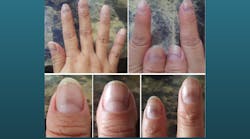The effects of hormonal contraceptives on oral health
The periodontium is affected by several factors that illicit an immune response, which then cause destruction of the supporting periodontal structures. Oral-systemic health is a continually evolving area that demonstrates the relationship between numerous conditions and oral health. The influence of hormones, specifically those found in oral contraceptives, on periodontal health has been researched for years, and a few definitive correlations were recently identified.
Studies conclude that women taking oral contraceptives present with worse periodontal and gingival health than their counterparts who do not take this medication.1 Here I’ll look at current literature about the changes hormones can have on a patient’s vasculature, immune system, and periodontium so that clinicians can educate patients on the oral health risks of hormonal contraceptives.
Overview of hormonal contraceptives
Hormonal contraceptives, which have been used for decades, have varying purposes and components that have evolved to meet the specific needs of women. Whether the contraceptive is oral, intrauterine, or intramuscular, each is based on synthetic combinations of estrogen and progesterone, progesterone alone, or levonorgestrel to mimic a state of pregnancy to prevent ovulation.2
Estrogen’s role in contraception is to inhibit ovulation, regulate bleeding, and keep the endometrial lining thin, while progesterone inhibits ovulation and thickens cervical mucus.2 The amount of hormones present can vary in oral contraceptives. Some deliver a consistent amount of hormones throughout the month, while others increase once or twice throughout a woman’s menstrual cycle.2 This is important to consider when evaluating the effects of hormones on oral health. If estrogen and progesterone levels become elevated, vasodilation of blood vessels and capillary permeability is induced, which results in migration of fluid and white blood cells out of blood vessels. This leads to increased blood flow to gingival tissues, along with sensitivity, irritation, and inflammation.3,4,5
These inflammatory changes appear synonymous with symptoms experienced by pregnant women.6 Hormonal contraceptives play a substantial role in empowering women to have a say in their fertility, however, as dental professionals it’s critical to understand how these hormones can contribute to tissue destruction at the microbial level.
Risks to oral health
Healing capabilities: Most dental professionals are familiar with collagen, as the periodontal ligament is made up of collagen fiber bundles that suspend the tooth into the alveolar bone. Considering the effects of elevated progesterone and estrogen on the vasculature, changes in these hormones negatively influence the immune system and collagen production by reducing the body’s ability to repair and maintain gingival tissues.3
In a meta-analysis that evaluated alveolar osteitis occurrence in oral contraceptive users, the average rate of alveolar osteitis in those who used oral contraceptives was 13.9% in comparison to 7.5% in nonoral contraceptive users.2 In addition to estrogen’s impact on the body’s ability to heal, it also affects one’s ability to coagulate and has been shown to cause changes in fibrinolytic factors. These factors play a large role in keeping clots stable, however, without adequate fibrinolytic factors, there’s greater incidence of clots breaking down and inadequate healing.2,6
Another study looked at implant success rates among women taking systemic steroids, hormone replacement therapy, or oral contraceptives.5 In this study, 777 women were evaluated—those with implant failures who were taking hormone replacement therapy or oral contraceptives, and those not taking these medications.6 After excluding patients who smoked and had diabetes, the results indicated that the implant failure rate was 8.62% for patients taking hormone replacement therapy or oral contraceptives, compared to 1.53% of patients not taking these medications.5 This reveals that how an implant osseointegrates into the bone could be largely dependent on systemic medications and hormonal influences.
Periodontal health: Regarding gingival and periodontal health, even low-dose contraceptives have been shown to lead to increased gingival bleeding, which is correlated to the effects of elevated estrogen and progesterone on the vasculature.2 Estrogen receptors are found in the fibroblasts and osteoblasts of the periodontal ligament. Considering the effects of elevated estrogen levels, these receptors bind to specific hormones that accumulate in tissues and influence an inflammatory response in the gingiva.2,5,6 This leads to destruction of the periodontium, increased probing depths, clinical attachment loss, and bleeding.
Many clinical studies have demonstrated that the concentrations of C-reactive protein (CRP) in patients taking oral contraceptives is higher than those who are not.5 CRP becomes activated in response to acute and chronic inflammation. This protein recognizes when there’s injury to periodontal tissues and plays a pivotal role in the host’s defense against infection that’s eliciting the inflammatory response.7
What are the conclusions?
A systematic review evaluating oral health and oral contraceptive use determined that duration of contraceptive use was correlated with worsening gingival parameters. Women on oral contraceptives for more than 18 months had greater clinical attachment loss compared to those using a contraceptive for a shorter time.3,6 For all these reasons, studies have correlated women taking hormonal contraceptives with worse gingival and periodontal health.1-3,6
Understanding the influence a patient’s medical history has on oral health goes beyond updating medications at every appointment. Prescriptions patients take could be a contributing factor to changes in inflammation or alveolar osteitis, despite the patient following strict postoperative instructions. The conditions discussed here are certainly multifactorial, with the effects of systemic medications being just part of a patient’s oral and systemic health.
It’s critical to shed light on the impact these hormones have on the oral health of patients, as many studies are concluding a positive correlation between these medications and poor periodontal outcomes. It’s our responsibility to make our patients aware of the possible effects that hormonal medications could have on their vasculature, immune system, and periodontal health.
References
1. Bienek DR, Filliben JJ. Risk assessment and sensitivity meta-analysis of alveolar osteitis occurrence in oral contraceptive users. J Am Dent Assoc. 2016;147(6):394-404. doi:10.1016/j.adaj.2016.01.011
2. Rojo GM, Lloret MRP, Gironés JG. Oral manifestations in women using hormonal contraceptive methods: a systematic review. Clin Oral Invest. 2024;28(184):1-13. doi:10.1007/s00784-024-05573-x
3. Ali I, Patthi IAB, Singla A, et al. Oral health and oral contraceptive: is it a shadow behind broad daylight? A Systematic Review. J Clin Diag Res. 2016;10(11):1-6. doi: 10.7860/JCDR/2016/19439.8790
4. Boyapati R, Cherukuri SA, Bodduru R, et al. Influence of female sex hormones in different stages of women on periodontium. J Mid-life Health. 2021;12:263-266. doi:10.4103/jmh.jmh_142_21
5. Zou MY, Cohen RE, Ursomanno BL, et al. Use of systemic steroids, hormone replacement therapy, or oral contraceptives is associated with decreased implant survival in women. Dent J. 2023;11:1-9. doi: 10.3390/dj11070163
6. Lamichange M, Salehi N, Ahmadjee A, et al. Cardiovascular Thrombus. Elsevier. 2018.
7. Bansal T, Pandey A, Asthana A, et al. C-reactive protein (CRP) and its association with periodontal disease: a brief review. J Clin Diagn Res. 2014;8(7): 21-24. doi:10.7860/JCDR/2014/8355.4646
About the Author

Annie Walters, MS, RDH
Annie Walters, MSDH, RDH, has extensive experience as an oral health-care provider. She has spent time caring for individuals in Guatemala and Indian Health Service sites and is passionate about advancing access to care for individuals with specialized health care needs. She is a published author and is trained in Orofacial Myofunctional Therapy. Annie received her graduate degree from the University of New Mexico and currently serves as an assistant clinical professor at Northern Arizona University. Reach her at [email protected].


